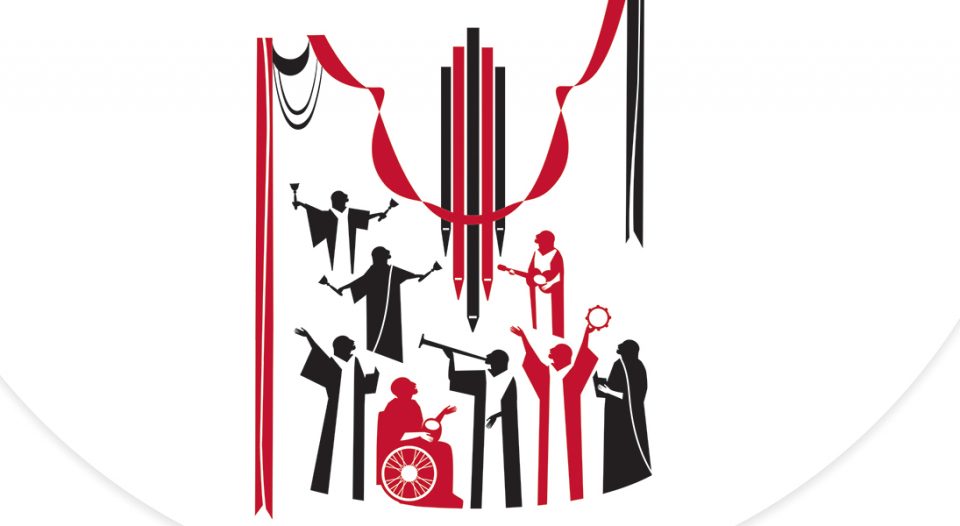Editor’s note: Martin Luther famously said, “Next to the Word of God, music deserves the highest praise” (Luther’s Works, Vol. 53). The ELCA still holds tightly to Luther’s understanding. This is the last article in a six-part series in which we’ve explored Lutheran music throughout history, the importance of music to the Lutheran faith and how that tradition continues today across styles and expressions.
Music styles vary across the ELCA, depending on a congregation’s personality and available resources. Some congregations support large choirs, others have bands or cantors, and some rely on the congregation’s voice.
Sanctuary in Marshfield, Mass.; St. Peter Lutheran, New York City; and Prince of Peace Lutheran, Dublin, Ohio, are congregations with distinctive music programs that still hold true to the Lutheran identity.
“Stay true to who the church is,” said Sarah Huber, a deacon and music director at Sanctuary.
Sanctuary isn’t a traditional congregation and its music program is equally unique. A band leads its three worship services, which are attended by approximately 170 people.
“Whatever music a church offers has to be indigenous to the folks,” Huber said. “Our people aren’t that excited by the organ.” In fact, the church doesn’t even own one.
A blended congregation of the ELCA and the United Methodist Church, Sanctuary is an 8-year-old community that appeals to people who’ve been unplugged from worship. With a median member age of 42, the congregation likes a more contemporary music style, she said.
“Rather than having one person lead the worship, like an organist or pianist, we have four to seven people on any given Sunday morning,” she said. “We usually have a keyboard player, drummer, two guitarists and vocalist. Sometimes bass, sometimes mandolin.” Huber, who plays keyboard and guitar and sings, coordinates the band each week from a roster of about 20 musicians.
“We pull our music from a few different places,” she said. “We sing songs that are out of the hymnal but mostly sing music that is more contemporary. It must be good, theologically sound and have integrity. If a song speaks to us, we’re not afraid to dip outside of the Christian realm.
“When people tell us what they like about Sanctuary, Pastor Mark [Huber’s] message is usually at the top, and right after that, it’s the music.”
“Spiritual home” with jazz
St. Peter in Manhattan is well-known throughout the city for its jazz program. Ike Sturm, director of music for its jazz ministry, has been at St. Peter for 14 years, but jazz has been there since 1955.
Every Sunday at 6 p.m. the congregation has jazz vespers. “We’re dreaming up new music all the time,” said Sturm, who plays bass. “I write new music and different groups come in to play every week.” For example, an Advent vespers included a string quartet.
“There’s something about improvisation that needs critical listening, compassion and empathy. It’s how our Christian family should be. It’s how God calls us to be together in the world, especially in this time of distance and disconnection.”
Jazz is more than just a music program at St. Peter. “The jazz ministry has been connected to jazz music and their families, caring for the musicians who play [in New York City] and their loved ones. It’s great for musicians to have a home,” Sturm said. “A lot of people in the jazz community talk about this church as a spiritual home for musicians.”
The program is always growing, he said, adding, “It’s a mission and vocation for me. It’s the way I live my life. All the parts of my life are interconnected. I might be out and hear someone play, and I’ll invite them to St. Peter’s.”
Five to eight jazz musicians generally play each week at vespers. Last year the congregation hosted a big band for a packed sanctuary.
“Vespers invite people in to hear the Gospel and the readings,” Sturm said, adding that the funky, blues nature of jazz music also brings people together. “There’s something about improvisation that needs critical listening, compassion and empathy. It’s how our Christian family should be. It’s how God calls us to be together in the world, especially in this time of distance and disconnection. So much of life is improvised.”
Back to basics
Prince of Peace has “a fairly traditional approach to music,” said Jeremy Bankson, director of music. What makes it stand out is its robust choirs—40 members in the adult group—and talented voices in the congregation.
But being traditional “doesn’t mean we don’t do a wide range of styles, from early chants to modern compositions,” he added.
Bankson said the core of the music program is to support worship and the readings. About 500 people attend worship across four services. The choir sings at the 11 a.m. service, but each has a well-rounded music experience from hymnody to liturgy, including a cantor to lead singing.
“Being creative in worship is important,” he said. “We may be singing a hymn that we’ve sung for 50 years, but we bring a freshness to it. Music should be creative, thoughtful and well done.”





